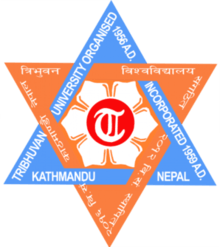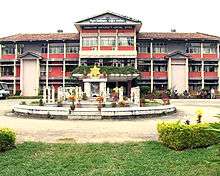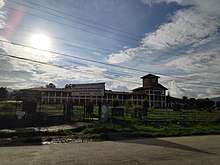Tribhuvan University
Tribhuvan University (TU; Nepali: त्रिभुवन विश्वविद्यालय) is a public university for higher education, located in Kirtipur, which is an ancient city in the Kathmandu Valley of Nepal. The university, established in 1959, is the oldest university in Nepal.[4] In terms of enrollment, it is the 12th largest university in the world. The university offers 2,079 undergraduate and 2,000 postgraduate programs across a wide range of disciplines. As of March 2017, the university has 60 constituent campuses and 1,084 affiliated colleges across the country.[5] Since it is government financed, it is less expensive than private universities.
त्रिभुवन विश्वविद्यालय | |
 Logo of Tribhuvan University (blue and red hexagram) | |
| Type | Public |
|---|---|
| Established | 1959 |
| Budget | Rs 1.5 billion (USD $130 million) for 2019–2020[1] |
| Chancellor | Prime Minister of Nepal |
| Vice-Chancellor | Dr. Dharma Kanta Baskota |
Academic staff | 7,049 professorial faculty 5607 other faculty[2] |
| Students | 604,437[3] |
| Location | , |
| Campus | Kirtipur |
| Website | tribhuvan-university.edu.np |
History
Established on 25 June 1959 (or 11 Ashar 2016 BS),[6] Tribhuvan University is the oldest and largest university in Nepal. The university was named after the late King Tribhuvan. In its early years, all the postgraduate classes were held at Tripureshwor Campus. The administrative office was also located in Tripureshwor. It was only in 1967, that the university was relocated to its main campus in Kirtipur – an ancient town about 5 km south-west of the city of Kathmandu. The university, which spreads over an area of 154.77 hectares, constitutes the Central Administrative Office and the Central Campus.[7]
TU marked its golden jubilee in 2009 organizing programmes.
Academics


Since its inception, the state-owned university has expanded its programmes. There are five technical institutes and four general faculties. The university offers 115 courses for the technical proficiency certificate level. TU offers 1079 courses at Bachelor's level and 1000 courses at Master's level. It offers Ph.D. degrees in the technical institutes and faculties.
TU ran its programmes only through its constituent campuses before 1980. With the increasing number of students wanting higher education, it was not possible to accommodate all the students in the constituent campuses. This situation led to the establishment of colleges in the private sector because the constituent campuses alone could not meet the demand. From 1979–80, TU started providing affiliation to private colleges. As of April 2016, 1,084 private and public colleges were affiliated with TU.[8]
In the 2014–2015 academic session 4,05,341 students were enrolled in TU academic programmes. 1,48,141 (36.55%) students study in its 60 constituent campuses including 38 central departments, while 2,57,200 (63.45%) students study in 1,053 affiliated colleges.[9]
TU has 7,841 teaching faculty and 7,413 non-teaching staff including the support staff in its constituent campuses. The number of total employees is 15,254.[10]
Rankings
Tribhuvan University is ranked as 1001+ universities of the world as per the Times Higher Education World University Rankings in 2020, published by the Times Higher Education (THE) magazine. It is ranked among the 251-300 best universities of Asia.[11] It is ranked at 7470 in the world and 3rd in the country as per the 4icu Organisation of Uiversity Ranking.[12]
Technical institutes
The university administers its science and technology programs, such as BSc, BE, MBBS, etc., through its technical institutes. There are five technical institutes at the university, each taking care of a specific domain within the field of science and technology education.
- Institute of Agriculture and Animal Science
- Institute of Medicine
- Institute of Engineering
- Institute of Science and Technology
- Institute of Forestry
Faculties and associated central departments
There are four faculties and a total of 38 associated central departments at the university
- Central Department of Management
- Faculty of Humanities and Social Sciences
- Central Department of Anthropology
- Central Department of Botany
- Central Department of Buddhist Studies
- Central Department of Chemistry
- Central Department of Computer Science and Information Technology
- Central Department of Nepalese History, Culture and Archaeology
- Central Department of Economics
- Central Department of English
- Central Department of Environmental Science
- Central Department of Biotechnology
- Central Department of Fine Arts
- Central Department of Food Technology
- Central Department of Geography
- Central Department of Hydrology and Meteorology
- Central Department of Geology
- Central Department of Hindi
- Central Department of Home Science
- Central Department of Journalism and Mass Communication
- Central Department of Library Science
- Central Department of Linguistics
- Central Department of Maithili
- Central Department of Mathematics
- Central Department of Microbiology
- Central Department of Nepali
- Central Department of Nepal Bhasha
- Central Department of Physics
- Central Department of Political Science
- Central Department of Population Studies
- Central Department of Psychology
- Central Department of Rural Development
- Central Department of Sanskrit
- Central Department of Sociology
- Central Department of Statistics
- Central Department of Zoology
- New Master's Programmes under the Faculty of Humanities and Social Sciences:[13]
- Master's Programme in International Relations and Diplomacy (MIRD)
- [[Masters of Arts in Crisis Management Studies (ICMS)[14]
- Master's of Social Work
- Sports Science
- (The new programmes are designed and run in the semester system.)
- Faculty of Management
- Faculty of Education
- Faculty of Law
Constituent Campuses
The following is a partial list of constituent colleges of the university:[15]
Eastern Development Region
- Mahendra Ratna Multiple Campus, Ilam
- Mechi Multiple Campus, Jhapa
- Mahendra Morang Adarsh Multiple Campus, Biratnagar
- Snatakottar (Postgraduate) Campus, Biratnagar
- Nursing Campus, Biratnagar
- Purwanchal Campus, Dharan
- Mahendra Multiple Campus, Dharan
- Central Campus of Technology, Dharan [16]
- Dhankuta Multiple Campus, Dhankuta
- Tehrathum Multiple Campus, Chuhandanda, Terhathum
- Bhojpur Multiple Campus, Bhojpur
- Mahendra Bindeshwori Multiple Campus, Rajbiraj
- S.S.M.Yadhav Multiple Campus, Siraha
- Panchthar Multiple Campus, (Panchthar)
Central Development Region (out of Kathmandu Valley)
Central Development Region (Inside Kathmandu Valley)
- Bhaktapur Multiple Campus, Bhaktapur
- Sanothimi Campus, Bhaktapur
- Patan Samyukta Campus, Patan Dhoka
- Pulchowk Campus, Pulchowk
- Nepal Commerce Campus, Min Bhawan
- Thapathali Campus, Thapathali
- Jana Prasashan Campus, Jamal
- University Campus, Kirtipur
- Mahendra Ratna Campus, Tahachal
- Ayurved Campus, Kirtipur
- Public Youth Campus, Dhobichaur
- Saraswoti Multiple Campus, Lainchaur
- Amrit Campus, Lainchaur
- Central Campus, Maharajgung
- Nursing Campus, Maharajgunj
- Lalitkala Campus, Bhotahiti
- Trichandra Multiple Campus, Ghantaghar
- Padmakanya Multiple Campus, Bagbazar
- Shankerdev Campus, Putalisadak
- Ratna Rajya Laxmi Campus, Pradarshani Marg
- Nepal Law Campus, Pradarshani Marg
- Bishwa Bhasa Campus, Pradarshani Marg
Western Development Region
- Gorkha Campus, Gorkha
- Lamjung Campus, Sundarbazar
- Paschimanchal Campus, Pokhara
- Pokhara Nursing Campus, Pokhara
- Pokhara Campus, Pokhara
- Prithivi Narayan Campus, Pokhara
- Tribhuvan Multiple Campus, Palpa
- Butwal Multiple Campus, Butwal
- Paklihawa Campus, Paklihawa
- Bhairahawa Multiple Campus, Bhairahawa
- Dhaulagiri Campus, Baglung
- Janapriya Multiple campus, Pokhara
Mid-Western Development Region
- Mahendra Multiple Campus, Dang
- Rapti Babai Campus, Tulsipur, Dang
- Mahendra Multiple Campus, Nepalgunj
- Nursing Campus, Nepalgunj
- Surkhet Campus, Birendranagar
- Jumla Campus, Jumla
- Musikot Multiple Campus, Rukum
Far-Western Development Region
- Doti Multiple Campus, Doti
- Dadeldhura Campus, Dadeldhura
- Siddhanath Science Campus, Mahendranagar
- Kailali Multiple Campus, Dhangadhi
- Jagannath Multiple Campus, Baitadi
- Krishna Snatak Campus, Darchula
- Gokuleshwor Multiple Campus Darchula
- Mahakali Multiple Campus, Kanchanpur
Organization
TU is government financed but still an autonomous organization.[2] The head of the government, the prime minister, is its chancellor.[17]
- Chancellor: Prime Minister of Nepal (Khadga Prasad Oli)
- Pro-Chancellor: Minister of Education (Giriraj Mani Pokharel)
- Vice Chancellor: Prof. Dr. Dharma Kant Baskota
- Chairman: Prof. Chaitanya Prasad Sharma
- Rector: Prof. Dr. Sudha Tripathi
- Registrar: Prof. Dr. Peshal Dahal
Council
Tribhuvan University has five decision-making bodies:
- The University Council is the supreme body that makes decisions on policies, budget, rules and regulations and the formation of special committees and commissions.
- Executive Council implements operational decisions while the University Council accepts donations to the university. It makes decisions on grants, affiliation to private campuses and appointments of university officials.
- The Academic Council makes decisions on policies and practices regarding curriculum, teaching, examinations and research.
- The Research Coordination Council makes policies on TU research activities, approves guidelines for researchers and coordinates the functions of university level research organizations.
- The Planning Council has an advisory role of preparing plans (long- and short-term), developing annual programs and evaluating programs implementation.
Societies
- Nepal Chemical Society
- Nepal Mathematical Society
- Nepal Physical Society
Research centers
Tribhuvan University has the following research centers:[18]
- Centre for Economic Development and Administration (CEDA)
- Centre for Nepal and Asian Studies (CNAS), formerly called the Institute for Nepal and Asian Studies (INAS)
- Research Centre for Applied Science and Technology (RECAST)
- Research Centre for Educational Innovation and Development (CERID)
References
- Kantipur Newspaper. ekantipur. Kantipur Publications https://ekantipur.com/news/2019/11/29/157504260514197632.html. Retrieved 30 November 2019. Missing or empty
|title=(help) - "http://web.archive.org/web/20071006012638/http://www.tribhuvan-univer…". archive.is. 6 October 2007. Archived from the original on 6 October 2007. Retrieved 30 March 2019. External link in
|title=(help) - "Tribhuvan university".
- "Nepal :: Health and education". Britannica Online Encyclopedia. Retrieved 9 February 2010.
- "FSU elections held in just 143 colleges". Republica. 2 March 2017. Retrieved 2 March 2017.
TU has 60 constituent colleges and around 1,084 affiliate colleges including community colleges across the country, according to TU officials.
- K.C., Tanka (2009). प्रज्ञान प्रतियोगितात्मक सामान्यज्ञान [Pragyan Competitive General Knowledge] (in Nepali). Kathmandu, Nepal: Pragyan Prakashan. p. 77.
- "About Us". tribhuvan-university.edu.np. Tribhuvan University. Retrieved 6 October 2016.
- "Over 1,000 colleges only temporarily affiliated to Tribhuvan University - The Himalayan Times". The Himalayan Times. 9 April 2016. Retrieved 24 January 2017.
- "About Us - Tribhuvan University of Nepal". tribhuvan-university.edu.np. Retrieved 25 May 2015.
- "about us".
- "Tribhuvan University". Times Higher Education (THE). 10 April 2019. Retrieved 17 May 2019.
- "Tribhuvan University World Ranking 2020". 4icu.org. 2005-2020 uniRank ™. Retrieved 8 March 2020.
- "Faculty of Humanities and Social Sciences | Tribhuvan University of Nepal". tribhuvan-university.edu.np. Retrieved 14 October 2017.
- http://www.tuicms.edu.np
- "LIst of Constituent Campuses of Tribhuvan University". Tribhuvan University's Official Website. TU. Retrieved 31 May 2016.
- "Welcome :: CCT Dharan". www.cctdharan.edu.np.
- "PM Dahal stresses need of reforming TU". Retrieved 24 January 2017.
- "TU Research Centres". http://tribhuvan-university.edu.np. Retrieved 20 October 2018. External link in
|website=(help)